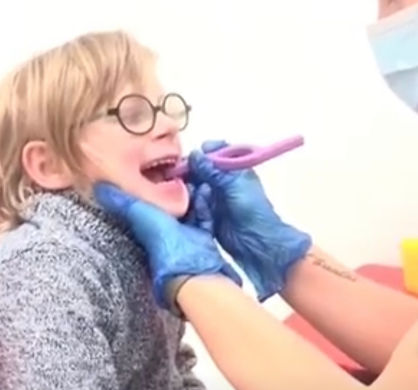5970 Centre St S, Unit 100 Calgary, AB, T2H0C2
Formerly known as SMILE Therapy for Kids Calgary
Help us fundraise for a medium Trexo Robot
Speech-Language Pathology

What does a Speech Language Pathologist Do?
At Canadian Centre for Development, our Calgary Pediatric Speech Language Pathologist helps children with most aspects of communication and feeding. Being that communication can come in many forms, such as body language, eye gaze, vocalizations, language, sign language, written, AAC (augmentative and alternative communication) and other expressions, these are all areas that our SLPs explore with clients.
SLPs also look at oral motor skills and manners in which under-development may be limiting the child with eating, speaking, drooling, having proper mouth rest posture, and breathing.
Not sure which of our SLPs would be most fitting for your child and their challenges? If so, be sure to give us a call and we'd be happy to guide you in your decision.
The first appointment will allow us to learn all about your child and create a plan of action to get them to your/their goals.
Types of Communication Challenges:
At the Canadian Centre for Development we support all children whom are struggling with communicating their needs and wants. Most speech disorders fall into the following categories:
-
Speech delays and disorders including articulation, phonology and motor speech disorders
-
Language delays and disorders, including expression and comprehension in oral and non-verbal contexts
-
Voice and resonance disorders
-
Cognitive-communicative disorders including social communication skills, reasoning, problem solving and executive functions
-
Pre-literacy and literacy skills including phonological awareness, decoding, reading comprehension and writing
-
Neuromotor disorders that limit the child's ability to communicate orally
Conditions that we see at CCD are: Apraxia, Aphasia, Dysarthria, Hearing Disorders, Autism, Physical Disabilities, Late Talkers, Speech Delays, Orofacial Myofunctional Disorders, and others.
Specialty Techniques and Methodologies

Oral Placement Therapy
Oral Placement Therapy (OPT) utilizes a combination of: (1) auditory stimulation, (2) visual stimulation and (3) tactile stimulation to the mouth. It is used to help children and individuals to improve speech clarity and feeding skills. OPT can be used with clients of many ages and ability levels. It can be incorporated into program plans for many types of speech disorders. Clients with motor and/or sensory impairments benefit from the tactile and proprioceptive components.

Orofacial Myology (or 'Oral Facial Myofunctional Therapy')
The assessment and treatment of the oral and facial muscles and how they affect speech clarity, chewing, collect a bolus, swallowing, dentition, proper mouth resting posture, mouth breathing, thumb or clothing sucking, tongue thrust, and others.

Augmented and Alternative Communication (AAC)
SLPs work closely with clients to assess their unique communication challenges, considering factors such as speech, language, and motor abilities. They then collaborate with individuals and their families to select appropriate AAC strategies and devices tailored to the individual's specific needs. SLPs provide training on the effective use of AAC systems, helping clients develop the skills to express themselves successfully.

Beckman Oral Motor Method
The Beckman Oral Motor Method is a structured and evidence-based approach designed to address oral motor dysfunctions by improving muscle strength, range of motion, and oral motor control. This method uses a series of specific, targeted interventions to facilitate functional improvements in feeding, speech, and swallowing. Unlike traditional oral motor exercises, the Beckman method focuses on hands-on techniques that involve gentle stretching, stimulation, and manipulation of the oral and facial muscles. By addressing the root causes of oral motor challenges, this approach helps individuals develop the necessary motor skills for efficient chewing, swallowing, and articulation. It is particularly beneficial for children and adults with developmental delays, neurological conditions, or other factors impacting oral motor function.

Feeding Assessment and Feeding Therapy
A feeding assessment and feeding therapy focus on identifying and addressing challenges related to feeding, swallowing, and oral motor function. The process begins with a thorough assessment, during which a trained therapist—often a Speech-Language Pathologist (SLP) or Occupational Therapist (OT)—evaluates factors such as chewing abilities, swallowing safety, posture, sensory responses, and mealtime behaviors. This may involve observing the individual eat and drink, assessing oral motor skills, and gathering information about feeding history and routines. Based on the assessment, a personalized therapy plan is developed to address specific needs, such as improving oral motor coordination, managing sensory sensitivities, or enhancing safe swallowing techniques. Feeding therapy aims to create positive mealtime experiences, support safe and efficient feeding, and promote overall nutritional well-being for individuals of all ages.

Pre and Post Tongue-Tie Release Assessment and Therapy
Tongue-tie release therapy is a specialized approach designed to optimize oral function before and after a tongue-tie release procedure (frenectomy). Before the release, therapy focuses on preparing the oral muscles through exercises and techniques that improve strength, mobility, and coordination. After the procedure, therapy supports proper healing, prevents reattachment, and helps individuals achieve functional improvements in feeding, swallowing, and speech. This comprehensive approach ensures that the tongue and surrounding muscles adapt effectively, promoting long-term success and improved quality of life.

Augmented and Alternative Communication (AAC)
SLPs work closely with clients to assess their unique communication challenges, considering factors such as speech, language, and motor abilities. They then collaborate with individuals and their families to select appropriate AAC strategies and devices tailored to the individual's specific needs. SLPs provide training on the effective use of AAC systems, helping clients develop the skills to express themselves successfully.


